Giacinto Boccanera was born in Leonessa and trained in Rome in ca. 1684 under Giacinto Brandi. One of his earliest signed works, a study (1689) for an altarpiece for the Duomo, Città delle Pieve, is now in the Pinacoteca, Bettona (see below). He moved to Perugia in ca. 1714, becoming Director of the Accademia di Belle Arti.
Cristoforo Gasperi served as his apprentice in the 1730s.
Perugia
St Pellegrine Laziosi (1705)
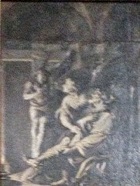
Scenes from the Life of Samson (1716)
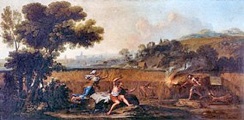
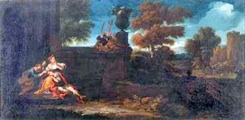
These two panels, which are signed by Giacinto Boccanera, form part of the Collection of the Fondazione Cassa di Risparmio di Perugia. They depict:
-
✴Samson burns Philistine crops; and
-
✴Delilah arranging the cutting of Samson’s hair.
Adoration of the Magi (1717)
This panel in Santa Maria di Colle is signed by Giacinto Boccanera and dated by inscription.
Deposition (1729)
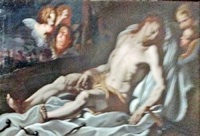
This altarpiece in the Museo Capitolare (Room 23), which presumably came from the Duomo, is signed by Giacinto Boccanera and dated by inscription.
Miracle of Pope Pius V (ca. 1730)
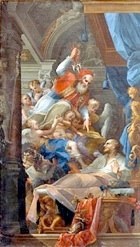
St Spyridon Baptises Emperor Constantius I (1731)
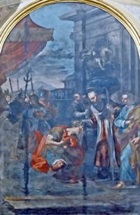
Saints (ca. 1734)
These two oval panels by Giacinto Boccanera, each of which depicts a saint (identify ?), are on an altar (which one ?) in Santa Teresa that was built in 1734.
Frescoes (1735)
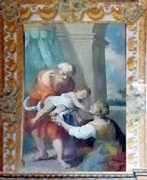
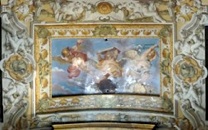
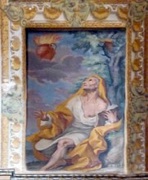
The frescoes in the arch above the Cappella di San Filippo of San Filippo Neri(in the right transept), which are by the ageing Giacinto Boccanera, are set in decorative chiaroscuro frames by Paolo Brizi. The fresco at the centre depicts angels with symbols of the Virtues, while those to the sides depict scenes from the Old Testament:
-
✴Elijah and the widow of Zarephath; and
-
✴Jeremiah contemplating a phoenix, which prefigures the resurrection of Christ.
Frescoes in Palazzo Donini (1745-50)
In the 14 rooms on the piano nobile of Palazzo Donini (including the Salone d’ Onore and the chapel) are mostly attributed to:
-
✴Pietro Carattoli (fictive architecture);
-
✴Nicolò Giuli (decorative elements); and
-
✴Francesco Appiani (figurative scenes).
However, the figurative scene in the sala del caminetto (the room of the fireplace), which depicts Apollo driving his chariot of fiery horses across the sky to give light to the world, is attributed to Giacinto Boccanera. Since he died in 1746, this was presumably the first room on this floor to be decorated and its fresco was probably Boccanera’s last work. The framing of the fresco (presumably by Pietro Carattoli) makes the most daring use of fictive perspectival architecture in the palace.
Miracle of St Pius V (18th century)
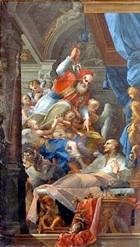
Bettona
St Sebastian tended by Irene (1689)
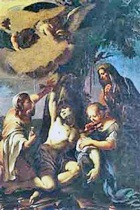
Cascia
SS Emidius, Francesco di Paola and Rita (18th century)
This panel is in the Museo Civico, Palazzo Santi.
Gubbio
St Philip Neri (18th century )
The altarpiece on the high altar of San Filippo Neri, which is attributed to Giacinto Boccanera, depicts St Philip Neri converting to Jews to Christianity. It suffered some repainting in the 19th century. It was removed from the church in ca. 1940 but returned after restoration in 2010.
Madonna and Child with angels (late 15th century)
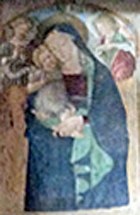
Massa Martana
Madonna and Saints (1723)
This altarpiece on the high altar of San Felice is by Giacinto Boccanera. It depicts the Virgin holding the consecrated host, with the Blessed Roger of Todi and SS Felix, Rita and Pius V.
Narni
Scenes from Via Crucis (1728-9)
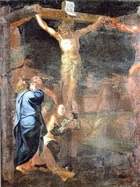
Spello
Trinity with Saints (18th century)
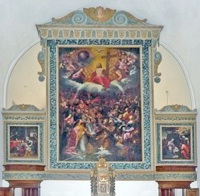
The main panel on the high altar of the “public” church of San Severino is by Giacinto Boccanera. The smaller panels to the side of it, which are attributed to him, depict:
-
✴the birth of Christ, on the left; and
-
✴the birth of St John the Baptist.
Todi
San Francesco di Paola (1712)




